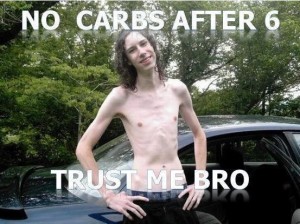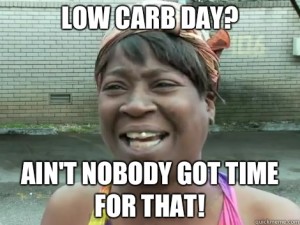It makes me sad that people restrict themselves from eating tasty foodz like potatoes and white rice because of the high and low GI (glycemic index – a measurement for foods and their impact on our blood sugar) rating these foods get.
What really is ridiculous is that people spin this GI/GL (glycemic load – similar to GI, except it takes into consideration the serving size) rating stuff so much that more and more people buy into it and start restricting all types of proper whole food, like the above, just because of it being labelled as ‘low’ or ‘high’.
What is also funny to note is that the difference between these two extremes is a mere 15 points.
Seriously? Seriously.
With this window of ‘low GI’ being considered anything that gets a score of 55 or lower, and ‘high GI’ given one that is anything above 70 [1], it leaves a lot of room for foods to appear above and below these numbers and creates a corner of the universe where foods that are as nutritionally gifted as a banana, are banished to.
Why the hate for the carbs, bro?
One of the big reasons why people like to scare people off from foods using this GI rating, is the thought that the consumption of carbohydrates plays with your insulin levels too much and results in weight gain. Whilst this is true due to our body raising our insulin levels to transport the glucose around our body, it’s only a fraction of the story.
Protein – everybody’s favourite macronutrient – has actually been shown to spike your insulin levels just as much, if not more, than carbohydrates. Which begs the question as to why all the hate is directed solely at carbs. And not to mention, whey protein has actually been shown to be the highest “spiker” out of fish, eggs and turkey too [2, 3, 4, 5].
But how does protein have that effect, you ask? Well, due to our body loving the amino acids that are found in proteins so much, it causes and stimulates an immediate rise in insulin levels for the delivery of nutrients [6, 7].
And whilst this overall thought that insulin is a bad hormone to be playing around with, it is actually known to be a great tool for stimulating and increasing muscle protein synthesis (ie. building dem gunz) [8].

So, keep in mind that if you’re planning to restrict foods prior to a workout due to your insulin spiking, that anytime you consume a protein and/or carbohydrate source, your insulin levels are going to spike (for 3+ hours) either way.
Satiety.
Another reason why people promote the low GI diets so much is the rate at which your hunger levels expose themselves and disappear.
You might be aware that white rice and potatoes have the reputation and rating of having a high GI. When in fact, they are two foods that actually rank higher than brown rice in terms of satiety levels [9, 10]. With the dreaded potatoes actually smashing all 38 foods that were tested out of the park. Crazy, right?
So now that we’ve detoured a fair bit and you’re now up to speed in regards as to why there are haters of high GI foods, let’s get back the number one reason why people tend to avoid them.

Weight gain.
The thought that consuming higher GI foods, spiking our insulin levels so much that we put on weight is highly wrong also. And studies have gone as far as to say that cutting your intake of foods to only low GI/GL has absolutely no benefit to energy intake restriction whatsoever [11, 12, 13].
Overall energy.
The main thing you’ve got to look at (like protein intake) when thinking of keeping your weight in check is the overall consumption of your calories within the day. If you’re eating more than you’re expending, then of course it’s going to result in weight gain over time [14].
But to restrict a food due to its GI rating or a macronutrient due to the thought process of it playing with your hormones too much, is simply too extreme and proves once again that just because something works for someone, doesn’t necessarily mean it is going to work for you.
As your insulin levels are going to spike and drop every time you consume food, regardless of type, it seems pointless to freak out about the differences between ‘high’ and ‘low’ GI carbs. Since at the end of the day (and even when you’re fasting) you’re levels will level out, and you’ll be in your favourite fat burning state anyway (also known as lipolysis).
Food preference and diet, in my opinion, should come down to an individual’s preference for certain foods, satiety levels and overall physical goals. Not a cookie-cutter approach that is handed out to every person.
Whilst the above might be a little hard to take in and consider given what you already may have heard, all the facts are backed up. And you can check them out via the links provided.
Any questions drop ‘em below.



